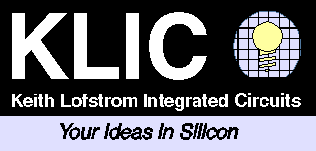

|
KLIC - Processes |
KLIC has experience in both CMOS and bipolar.
CMOS is cheap. 5 volt, 0.5 micron CMOS is a mature process, but has been used to build 22 bit ADCs, power amplifiers, GHz oscillators, and all sorts of nifty stuff.
If you don't need bleeding edge speed or noise performance, your design will probably work fine on a CMOS chip.
Variants of CMOS are available down to channel lengths of 90 nanometers. These processes are increasingly expensive, risky, and low voltage. Probably the "sweet spot" offering the most analog function per dollar is at 0.25 microns. The shorter channel processes usually provide 0.25 micron devices for peripheral drivers and analog cells, while offering the advantages of small linewidth interconnect.
Other variants of CMOS support electrically programmable and erasable devices ("E squared" processes ). These are available from a number of vendors, but the devices are usually specialized enough that a design targeted for one fab may not work on others.
BIPOLAR is deluxe. From 2x to 5x faster, a modern bipolar process is required for state-of-the-art communications devices. Since many good bipolar processes are intended for analog applications, these processes also have other good analog components such as nichrome resistors, schottky diodes, and high speed PNP transistors. However, bipolar is often more expensive.
BiCMOS processes are available from fabs such as IBM. These processes are as more expensive than simple bipolar or CMOS, but the mix of CMOS and bipolar parts offers great design flexibility.
There are a lot of processes out there. Choose a design shop free to help you choose the right one, not the only one they sell!
KLIC - your ideas in silicon!